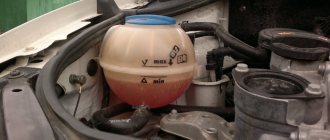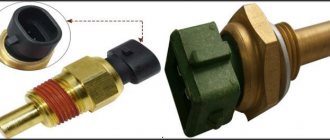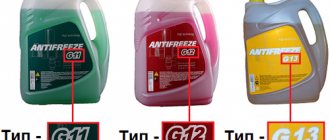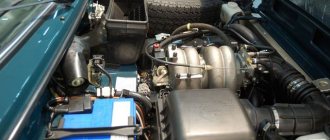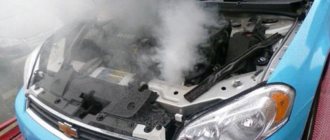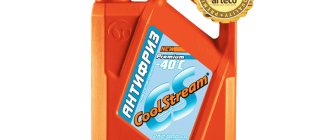It is well known that the problem-free operation of the power unit will depend on the condition of the engine cooling system. The car owner needs to check the antifreeze level on a regular basis, but it is not clear whether such work is performed on a hot or cold engine. Let's talk in more detail about how to properly check antifreeze in the cooling system.
Why do you need to monitor the antifreeze level?
The coolant is already in the cooling system duct before any machine is operated. If you are buying a used car, then one of the first steps during a technical inspection should be to measure the antifreeze level. By determining the readiness of the elements, we can draw a conclusion about the functionality of the car.
Why do you need to monitor the antifreeze level?
The cooling mixture prevents the engine from overheating. Antifreeze moves in a vicious circle, thereby increasing engine life. The entire cooling system is based on this technique.
Stages of work:
- when the engine heats up, the liquid circulates in a small circle;
- after reaching the temperature limit, a large circulation circle is turned on;
- the final cycle is the distillation of antifreeze through the cylinders to the radiator.
Antifreeze must be filled into the expansion tank to the optimal level. Only then is normal engine operation possible. The system does not have sensors, so you will have to determine the boundaries of the liquid yourself.
A limited amount of antifreeze in the cooling system leads to overheating of engine elements and wear, but an excess is no less dangerous. If the liquid is overfilled, a leak will form and the pipe and the expansion tank itself may rupture. Both options lead to depressurization of the system and rapid wear of the elements.
Should you mix antifreeze with water?
It is not worth purposefully diluting antifreeze with water to save money. If it’s a pity to throw out a properly working composition, but its level is not high enough, then it makes sense to add filtered or distilled water to maintain the volume. For example, if about 200 ml is missing from the standard level. But is it possible to dilute antifreeze with water, if we are talking about large volumes of the missing composition? Theoretically, it is possible, however, as in the case of combining two antifreezes, the risk of changing performance properties increases. The use of water is preferable in the sense that it does not lead to extreme modifications of the antifreeze with the precipitation of certain components. However, with large mixing proportions, it may well weaken the anti-corrosion properties and reduce the temperature resistance limits by 15-20%.
How to determine the coolant level
The cooling design consists of several elements. Due to the tightness of the system, some parts are not accessible for surface inspection. The driver can only control the condition of the tank, where the coolant level must be brought to the optimal level.
The difficulty of control is that the fluid usually lasts for a long time without refilling, so car owners often forget about the cooling system. When engine problems occur, faults within this area are the first to be suspected.
You can check the antifreeze level correctly only if the engine remains cold. The ideal level of the cooling compound is the limit set above the center line.
How to determine the coolant level
Why is verification needed?
Temperature fluctuations can be quite significant and in practice the difference sometimes reaches 150° C. For example, if the engine housing in operating mode heats up to +110° C, and the air outside is 40° C. Naturally, water is not suitable for these purposes, but cooling the liquid has the required characteristics.
Timely checking of its level is one of the basic criteria when servicing a car. It is necessary to provide the following parameters:
- Security. Overheating can cause unexpected breakdowns while driving, which can lead to extremely undesirable consequences.
- Economical. This procedure will save the car owner from expensive repairs caused by premature wear of car parts and components.
- Reliability. In winter, operating a modern car is impossible without antifreeze. An insufficient level of this liquid is extremely dangerous; it is no coincidence that the literal translation from English of this concept means “non-freezing”.
You can check the coolant level every time there is a reason to open the hood. It is recommended to regularly monitor its quantity, at least 2 times a year. A complete fluid change is done every 2-3 years.
What affects the coolant level?
The required amount of antifreeze keeps the vehicle systems in optimal condition. The characteristics declared by the manufacturer are achievable only at the recommended coolant level and directly affect the following parameters:
Boiling point. The calculated value is about 110° C. It is not recommended to warm up the engine above this value. The cooling system is designed in such a way that the continuous flow of coolant in a circle through the radiator and the power unit duct system maintains a temperature balance from 60° C to 108° C. Starting the engine
During the cold season, it is important that the antifreeze is mobile in the system. Water at temperatures below zero turns into ice, and the route of its movement in this case will be blocked, which will lead to overheating of the engine
Antifreeze and antifreeze, depending on the brand, do not freeze at temperatures down to -65° C. In most cases, the service life of coolant rated up to -40° C is sufficient; Operation of the hydraulic transmission system. In many modern cars with automatic transmission, it is necessary to maintain optimal temperature in the transmission. Coolant in this case is the most effective solution to the problem. Additives and additives in the composition of coolant. They give it additional qualities, and this, first of all, affects its anti-corrosion properties. In addition, the balanced composition prevents the formation of scale and has a lubricating effect.
How much antifreeze should there be?
The functions performed by the coolant are important in both summer and winter, so regular inspection of the system is an urgent need.
The lack or substandard quality of this fluid depletes the engine's life, and in some cases, leads to breakdown and, as a result, to expensive and troublesome repairs. You can check the status of the system in absolutely any car. This is not a difficult task, since machine manufacturers provide unhindered access to the control device.
Exact information about the volume of coolant for a specific model is indicated in the car's passport. It is also easy to find in specialized tables on thematic websites or by consulting with a mechanic or sales manager.
It is important to remember this rule: mixing antifreezes of different compositions is not recommended. You need to know the brand of your coolant, and in all doubtful cases, contact a specialist
Otherwise you will have to do a complete fluid change.
You need to know the brand of your coolant, and in all doubtful cases, contact a specialist. Otherwise, you will have to do a complete fluid change.
If, for example, blue antifreeze is filled, then you cannot add red.
But you shouldn’t focus only on color either. Different manufacturers use their own exclusive developments, but no one can guarantee the compatibility of ingredients with the same color.
What do the marks on the expansion tank mean?
The tank intended for filling antifreeze is a reservoir made of durable plastic. The configuration may vary, depending on the make of the car and the physical characteristics of the engine compartment. The tank has a screw cap with an air vent valve.
For some brands of cars, special local sensors have been developed that read the fluid level. For example, in VAZ or UAZ cars, the tanks are equipped with a second neck into which a special device is screwed. Most cars (even Mercedes, Mazda, Ford Fiesta) do not have a second neck, but are screwed on with a simple plug.
Some tanks have the usual markings:
- Max – maximum level;
- Min – minimum indicator.
For different brands of cars, the marks on the tank look different. On cars of the Skoda, Peugeot, and Nissan Vitz brands, the delimiters look like contrasting markers; for Opel, only notches are made on the tank. There are no marks on the capacitive tank of the Lada Kalina, but you can make them yourself.
Breach in the system
Antifreeze leakage is the most common problem. Over time, the pipes dry out and microcracks appear on them. The attachment points to the radiators and expansion tank also weaken. As a result, a small leak appears at first, which only gets worse over time. If the problem is not corrected, the pipe may eventually rupture. All the antifreeze will spill out, and the engine will overheat if this is not noticed in time.
To prevent this from happening, it is recommended to periodically change the rubber pipes, inspect the condition of the fasteners, etc. A leak may also occur as a result of a malfunctioning air valve. When there was too much pressure in the system, a weak point was found through which the coolant escapes. In this case, it is not clear how much antifreeze to fill, because its level will constantly change. It is advisable to eliminate the leak as soon as possible.
What indicators determine the fluid level in the expansion tank?
In theory, it seems that it is quite easy to control the level of coolant in the expansion tank, but practice shows that this is not the case.
The amount of coolant is directly dependent on temperature or weather conditions. In summer, antifreeze approaches its maximum value due to the expansion properties characteristic of all types of liquids, but in winter the level decreases.
The system does not have automatic sensors, so it is not easy to measure the amount of liquid yourself. Drivers use the car, but do not realize that the cooling is not enough.
What are they made of?
Among the first materials to be used for the production of rings were ductile iron alloys. It is this material that has shown its high efficiency. Cast iron went well with the materials used in the manufacture of cylinder blocks. The structure of such an alloy, which had pores, allowed the material to better retain lubricating fluid, and wear was significantly reduced. Today another cast iron alloy is widely used. This is a plastic look. Its advantage is its quality, which is much higher; in addition, it is subject to elastic deformation, which makes it easy to install the piston ring.
But the requirements for these parts are constantly growing. Therefore, engineers found more suitable materials. One of the first modifications was chrome plating of malleable cast iron. In this case, the chromium used was not the usual one, but a special, hard one. These products were first tested in aircraft engines.
Also, the material for making the rings was stainless steel. It is the next step after chrome plating of cast iron. The alloy also contains chromium, so similar properties can be observed here.
To increase the service life of these parts, engineers decided to create them from molybdenum. This material made it possible to increase wear resistance.
What level of antifreeze should be in the expansion tank?
The best option is to mark the antifreeze on the middle part. Then, when the liquid expands, leakage is excluded, and when the temperature of the coolant decreases, there will be enough to maintain operational readiness.
Drivers practice overfilling liquid when they want to prevent boiling over or underfilling. Maximum antifreeze can lead to an increase in pressure inside the engine. The result is pipe rupture. This, in turn, leads to loss of tightness. Minimal addition of antifreeze increases the risk of complete boiling of the liquid from the tank. In this case, the engine is at risk of severe overheating.
Why is verification needed?
Temperature fluctuations can be quite significant and in practice the difference sometimes reaches 150° C. For example, if the engine housing in operating mode heats up to +110° C, and the air outside is 40° C. Naturally, water is not suitable for these purposes, but cooling the liquid has the required characteristics.
Timely checking of its level is one of the basic criteria when servicing a car. It is necessary to provide the following parameters:
- Security. Overheating can cause unexpected breakdowns while driving, which can lead to extremely undesirable consequences.
- Economical. This procedure will save the car owner from expensive repairs caused by premature wear of car parts and components.
- Reliability. In winter, operating a modern car is impossible without antifreeze. An insufficient level of this liquid is extremely dangerous; it is no coincidence that the literal translation from English of this concept means “non-freezing”.
You can check the coolant level every time there is a reason to open the hood. It is recommended to regularly monitor its quantity, at least 2 times a year. A complete fluid change is done every 2-3 years.
What affects the coolant level?
The required amount of antifreeze keeps the vehicle systems in optimal condition. The characteristics declared by the manufacturer are achievable only at the recommended coolant level and directly affect the following parameters:
Boiling point. The calculated value is about 110° C. It is not recommended to warm up the engine above this value. The cooling system is designed in such a way that the continuous flow of coolant in a circle through the radiator and the power unit duct system maintains a temperature balance from 60° C to 108° C. Starting the engine
During the cold season, it is important that the antifreeze is mobile in the system. Water at temperatures below zero turns into ice, and the route of its movement in this case will be blocked, which will lead to overheating of the engine
Antifreeze and antifreeze, depending on the brand, do not freeze at temperatures down to -65°C. In most cases, the service life of coolant rated up to -40°C is sufficient; Operation of the hydraulic transmission system. In many modern cars with automatic transmission, it is necessary to maintain optimal temperature in the transmission. Coolant in this case is the most effective solution to the problem. Additives and additives in the composition of coolant. They give it additional qualities, and this, first of all, affects its anti-corrosion properties. In addition, the balanced composition prevents the formation of scale and has a lubricating effect.
How much antifreeze should there be?
The functions performed by the coolant are important in both summer and winter, so regular inspection of the system is an urgent need. The lack or substandard quality of this fluid depletes the engine's life, and in some cases, leads to breakdown and, as a result, to expensive and troublesome repairs.
You can check the status of the system in absolutely any car. This is not a difficult task, since machine manufacturers provide unhindered access to the control device.
Exact information about the volume of coolant for a specific model is indicated in the car's passport. It is also easy to find in specialized tables on thematic websites or by consulting with a mechanic or sales manager.
It is important to remember this rule: mixing antifreezes of different compositions is not recommended.
You need to know the brand of your coolant, and in all doubtful cases, contact a specialist. Otherwise, you will have to do a complete fluid change.
If, for example, blue antifreeze is filled, then you cannot add red.
But you shouldn’t focus only on color either. Different manufacturers use their own exclusive developments, but no one can guarantee the compatibility of ingredients with the same color.
What can be added and in what quantity?
The situation when you discover that there is not enough antifreeze in the tank requires immediate action. If leaks or breakdowns are excluded, this means that the cooling system needs to be replaced or topped up.
Experts recommend completely flushing the channels before adding new antifreeze. If you are on the road and do not have the opportunity to completely drain the old fluid, then you can simply add antifreeze into the channel. But even in this case, it is necessary to take into account the nuances.
It is strictly forbidden to mix liquids with different bases. For example, you cannot add mixtures of the first group with ethylene glycol to carboxylate-based antifreeze. As a result of the use of incompatible bases, a chemical reaction occurs and sediment is gradually released, which settles on engine elements or clogs the radiator.
When filling the cooling system, only mixtures are mixed that are based on additives with similar properties. For example, you can mix protective compounds with each other or add a small amount of antifreeze to red antifreeze with anti-corrosion properties. It is best to use fluids from the same car brand.
What can be added and in what quantity?
If the amount of antifreeze decreases due to a leak or damage to the channel, then directed repairs will be needed before changing or adding fluid.
Self-diagnosis of the malfunction
It happens that it is not always possible to contact a service station for diagnostics of the cooling system and subsequent repairs, so you need to know the main signs of its malfunctions.
Without starting the power unit, we check the condition of the oil in it. To do this, you need to remove the oil dipstick and inspect it carefully. Normally, there should be no traces of foreign liquid on it, except motor lubricant.
At the next stage of testing, we start the motor and wait until the fan starts working. In the meantime, we continue to monitor the condition of the cooling system, especially paying attention to the joints of the main hoses; usually, fluid leaks most often form in these places. It is possible that the radiator is leaking, but it is unlikely that you will be able to find the leak on it yourself.
Let's move on to checking the tightness of the tank. Very often, its lid does not fit tightly, which is why the liquid leaves its confines. At the same time, steam appears from under the hood, and traces of antifreeze evaporation are clearly visible on the tank and at its location.
Various malfunctions that result in the cylinder head being sealed also cause large amounts of coolant to leak. Naturally, it’s unlikely that you’ll be able to do anything here yourself, so the ideal solution to the problem would be to visit the nearest service station.
Perhaps the simplest way to check for antifreeze leaks is the following: just put a sheet of thick cardboard in the engine compartment overnight, which will collect the antifreeze on its surface in the event of a leak.
And, finally, do not forget that antifreeze is constantly evaporating from the system, so periodic monitoring of its level with subsequent topping up should become a necessary necessity for every car owner.
How to properly add coolant to the expansion tank
On popular car brands Hyundai Solaris, Toyota Lancer, Mitsubishi, Chevrolet or BMW, the procedure for filling antifreeze is the same. Let's analyze this manipulation in detail. For the listed brands, the expansion tank is located on the right side of the engine compartment. To measure and top up, it is better to follow the instructions:
- The machine is installed on a slope so that the front part is slightly higher. This will help expel excess air from the valve.
- Open the hood and carefully unscrew the tank cap.
- Liquid is added along one of the walls in a thin stream to avoid the formation of air pockets.
- Antifreeze is added to 2/3 (closer to the top mark than to the bottom).
- After this, the tank is closed and the engine is started so that the antifreeze begins to be distributed throughout the system.
- After stopping the engine, the antifreeze level in the expansion tank is checked again. The indicator should decrease slightly. To avoid excessive consumption, the liquid is refilled.
- After the second check, screw the tank cap tightly and close the hood.
Flushing the cooling system is necessary if the antifreeze inside the tank has changed its color or has become very thick. This condition can be caused by unwise mixing of formulations or purchasing low-quality raw materials.
It is recommended to check the antifreeze level in the expansion tank monthly. If you do not monitor the indicators, you can cause the engine to overheat. It is better to pour antifreeze “on cold” - this is the name for the technique when manipulations are carried out only when the car has cooled down. It is not recommended to mix formulations, but in some cases it is allowed to use mixtures with the same base.
How to add antifreeze - instructions
Every car needs a fluid that will cool its engine. Car owners will one day see that the antifreeze volume has dropped to the min level. What to do, how to add antifreeze? You can go to a service station, or you can top it up yourself. This topic is relevant for both beginners and experienced car enthusiasts.
be careful
Do not rush to add coolant when the engine is still hot. The consequences of this action are damage to the cylinder block. Make sure the engine is cold before adding coolant.
. If it is necessary to replenish the product level, but it is not possible to cool the engine, do this when it is warm.
Antifreeze must be topped up with liquid of the same brand. In order for the cooling of the system to be high-quality and correct, antifreeze must be added in combination with distilled water. We ratio liquids 1:1.
Mixing different coolants may result in premature repairs. During the process , try not to spill liquid on other parts.
, this may lead to their damage. In case of contact, wipe the surface.
If the coolant level is often at the min mark, do not rush to think about how to add antifreeze. Contact a service station or check the tightness of the cooling system yourself.
How to do it yourself
To avoid contacting service station workers, you can learn how to properly add antifreeze. Follow the rules written above and complete the following points.
Wrap your hand in a rag (wear gloves) and remove the expansion tank cap. Reduce the pressure by turning the cap one turn. As soon as it falls, remove the lid completely. Add liquid to the tank to medium level. We turn on the engine of the car. We give it time to work. We pay attention to how much antifreeze is available.
If necessary, fill the tank. The antifreeze should be at the level of the lower end of the radiator filler neck. We continue to add liquid. Do this carefully, without spilling. Close the lid.
To perform this procedure, you need to first prepare the cooler itself, distilled water with which you will dilute the cooler, a rag (gloves) and an expansion tank.
Water is different
Some car owners believe that in the summer they can drive only by filling the tank with water. This is a misconception.
Antifreeze can be diluted with distilled water, but in its pure form water will lead to rapid wear of parts. After using water, you will have to spend money on descaling the system. But the cooler includes various necessary components that ensure correct operation.
You may also be interested
Why does antifreeze thicken and turn into mush?
Many drivers, sooner or later, may encounter a situation where they see that the antifreeze has thickened or turned into porridge, that is, it has acquired an unusual consistency of jelly or thick yogurt. In order to protect your car from serious repairs, and yourself from an accident, it is better to fix this breakdown as soon as possible.
Why antifreeze is thrown out of the expansion tank: reasons, what to do
One of the most common problems faced by owners of domestic and imported cars is leakage or splashing of antifreeze from the expansion tank. What could be the reason for the release of liquid from the expansion tank, how to prevent such a breakdown and what to do if the refrigerant is pouring out of the cooling system?


